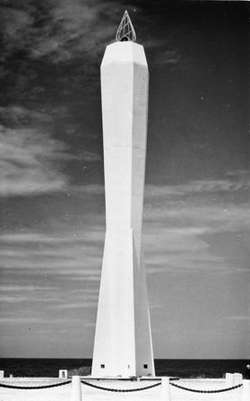- Author
- Wright, Ken
- Subjects
- Biographies and personal histories, Naval Intelligence, History - WW2
- Tags
-
- RAN Ships
- None noted.
- Publication
- March 2010 edition of the Naval Historical Review (all rights reserved)
Their contribution was out of all proportion to their numbers.
The Coastwatchers Memorial Lighthouse was erected in 1959 at Kalibobo Point in Madang, Papua New Guinea, by public subscription and by money from the Commonwealth Government of Australia. Shaped like a rocket or a bomb, the 80 feet high reinforced concrete column has an attractive base surround and a cruciform pathway approach. This Memorial Lighthouse was also designed to be a practical navigational aid with provision for the installation of a powerful 1,000,000 candlepower beam that would be visible up to 10 miles out to sea. Part of the inscription on one of three dedication plates reads:
‘In honour and grateful memory of the Coastwatchers and of the loyal natives who assisted them in their heroic service behind enemy lines during the Second World War in providing intelligence vital to the conduct of Allied operations. Not only did the Coastwatchers transmit by means of teleradio from their jungle hideouts information which led to the sinking of numerous enemy warships but they were able to give timely warning of impending enemy air attacks. The contribution towards the Allied victory in the Pacific by a small body of men who constituted the Coastwatchers was out of all proportion to their numbers’.

The man who was to do so much to ensure the success of the Coastwatcher concept, Eric Feldt, began his career as one of the first term cadets to enter the newly established Royal Australian Naval College at Geelong in Victoria in 1913. He resigned a few years later to work for the Australian Government in New Guinea as a District Officer. As his association with the people and the land grew, he came to know and understand the island people, the plantation managers and assorted government officials, and they in turn came to know and trust him. With the outbreak of World War II against Germany in 1939, approximately 800 Coastwatchers were under the control of the Royal Australian Navy Intelligence Division. Eric Feldt was by now a Lieutenant Commander on the Navy’s emergency list, and resigned his position as a district officer in New Guinea, rejoined the Navy and was appointed Staff Officer Intelligence at Port Moresby. His main duty was to organise and expand the civilian Coastwatchers.
The Coastwatchers were supplied with teleradios, a heavy and unwieldy radio and telegraph combination set. It was battery operated, with a voice range of 650 km and a telegraph range of around 950 km. The radio was sturdy and very efficient but because of its weight, batteries, charging engine and benzene fuel, it needed several men to carry the lot. The Coastwatchers were trained in the use of the ‘Playfair’ code, a low grade cipher based on a list of key words. Later coders, trained at HMAS Cerberus Signal School near Victoria’s Western Port Bay, were drafted to parties of Coastwatchers and Australian Army Commandos who operated as guerrillas. As an example, Naval Intelligence asked one Coastwatcher for his wife to provide some key words for use with the Playfair code. ‘What was the name of your sister’s racehorse? ‘Rainbird.’ ‘Where was your wife’s first teaching appointment’? ‘Deloraine.’ These would easily have been decoded by Japanese decoders within a week or two, so they were for immediate use only and not to be repeated.
By March 1942, Coastwatchers were positioned around the coasts of Papua New Guinea, the adjacent islands and the Solomon Islands and as they were now operating in enemy held territory, it was recommended that the Coastwatchers be appointed to naval rank although some opted to join the Army or the Air Force. This was not only for pay rates but primarily as active servicemen they would not be treated as spies but as Prisoners of War. As it turned out, the subtle difference of being a serving member in the Australian military or a civilian meant nothing at all to the Japanese as those who were caught were, in most cases, shown no mercy and summarily executed anyway.
Throughout the war, the information transmitted to the Director of Naval Intelligence by the Coastwatchers was comprehensive and accurate so there was little the Allies didn’t know about the strength and location of the enemy. Knowledge of the terrain in which they operated and the friendship and assistance of the local natives were the essential elements needed for the Coastwatchers to operate and evade Japanese patrols. In fact, without local native cooperation, it would have been very difficult, if not impossible, for the Coastwatchers to have achieved anywhere near the success they did. They were a mixed bag of soldiers, naval personnel, traders, planters, missionaries, colonial officials, a few women and locals. In most cases, they were thoroughly familiar with the area and many considered the South Pacific their home.




